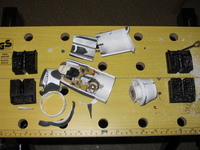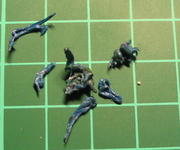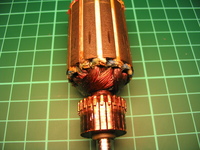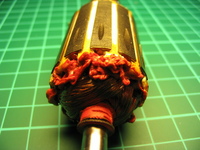Autopsy of a Blender
Traduction: [ Google | Babelfish ]
Catégories : [ Bricolage | Cuisine | Science ]
Today, I broke my hand processor (the thing on the left). I was preparing choco noursy v3 and the preparation was too thick. So the motor had difficulties for spinning, and since it could not deliver the energy into movement, it delivererd it as heat. I was aware the the device was heating, because I noticed it earlier, preparing older versions of Choco Noursy. So I was very careful to check that the body of the device was not becoming too hot. I was actually amazed that it didn't heat very much. What I didn't thought about, though, is the speed at which the heat would come out of the device. Now I know: it comes out slowly. Even when the device stopped working, the body was not hot. It became hot a couple of minutes later. But it was already all over (and you could tell simply by the smell of it). Also, there was a noise when you shook it.
 This is when I decided to make an autopsy of the corpse. Since it was all
sealed, I had to break it. I finally resorted to saw the body through in order
to check where the blue pellets were coming from.
This is when I decided to make an autopsy of the corpse. Since it was all
sealed, I had to break it. I finally resorted to saw the body through in order
to check where the blue pellets were coming from.
They came from the rotor of the electric motor. Diagnostic: the insulation material melted due to the heat. I'm not sure what it was insulating exactly, probably the different coils of copper wire forming the rotor. The other end of the rotor was also covered with melted red plastic.
So, what have we learned today? If the motor spins much more slowly than maximum speed, it is going to melt soon. Change the gear if possible (yes, I could have done that, the larger bowl of the blender has cogwheels in its hood, and spins more slowly, it is therefore better suited for thick preparations.
[ Posté le 27 août 2008 à 23:57 | 1 commentaire | lien permanent ]











When replacing your hand processor you might want to consider a combustion engine powered one. It probably wouldn't run out of power ;)
http://www.instructables.com/id/E3SI5W0GT2EP287XEL/